
This post may contain affiliate links.* As an Amazon Associate I earn from qualifying purchases. Click here to read our affiliate policy.

Estimated reading time: 26 minutes
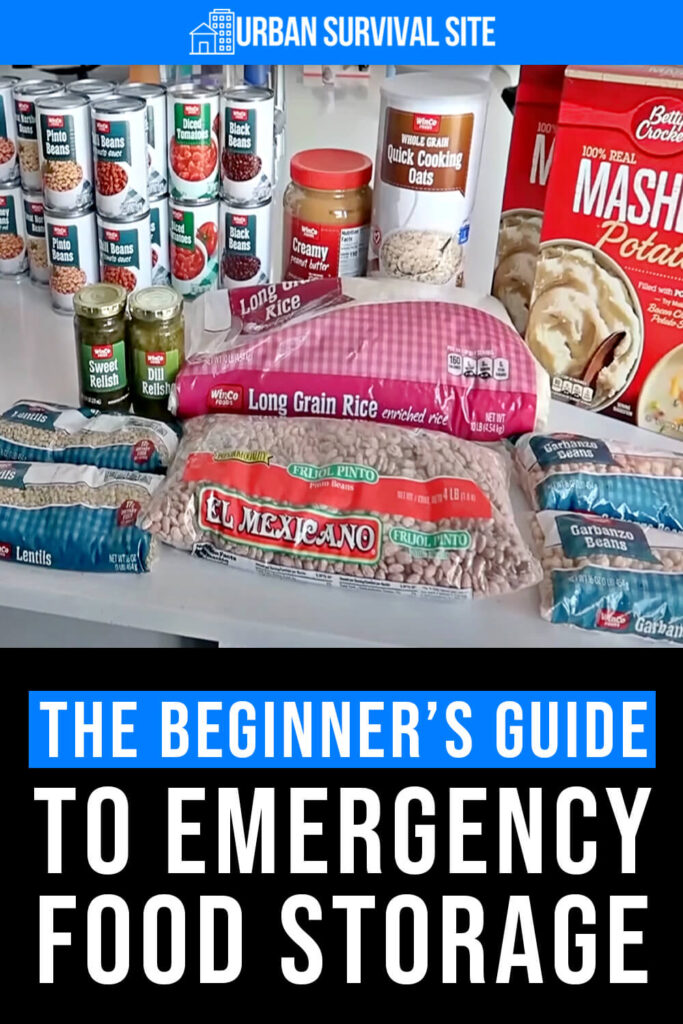
Having a large food stockpile is one of the main goals of every prepper. Unfortunately, many newbies think that all they have to do is run to the store and fill a cart with canned foods. This is a costly mistake. You need to take some time to figure out what foods to store and exactly how to store them.
Most of my readers already know the basics of emergency food storage, but I also have quite a few readers who are just getting started—people who have never used any food storage methods other than their refrigerator. This guide is my attempt to help them get started, and it's also a good refresher for more experienced preppers.
your family has something to eat after a major disaster.You will also know a little about the most common food storage methods, and you'll be able to avoid mistakes that could put your food supply in jeopardy. Remember, this isn't a race to see who can get the most food on the shelf. This is a methodical, lifelong process—not something you can do in one weekend.
Want to save this post for later? Click Here to Pin It on Pinterest!
Table Of ContentsBefore you start buying food, you need to consider where you will put it. This will have a big effect on how much you're able to store. If you have a small apartment with little storage space, you are going to have to get creative. Here are 20 food storage locations for people with small homes.
You probably already have some locations in mind. If not, here's a list of places that could make suitable food storage areas.
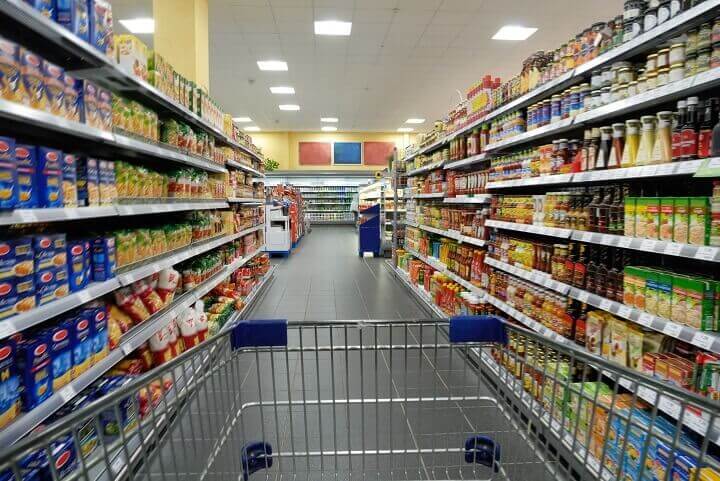
One of the most crucial food storage skills of all is knowing how to store a lot of food in a limited amount of space. This is especially important for those of you who live in apartments or condominiums, or those of you who simply have smaller pantries.
Fortunately, there are a variety of important tips that you can use to make the most out of limited space, including:
Shelves Under the Stairwell
Do you have any space under the stairwell? Don’t let it go to waste. You can clean the interior space out to place shelves in if you don’t have any already, and then you can store food and other supplies there. Normal food storage rules apply, so make sure the space is free of moisture and kept at a normal room temperature.
Shelves In Your Closet
If you have any extra space in your closet, you can take advantage of it. Just as you can add shelves under your staircase, you can add them to in closet as well.
Under The Bed
Do you have any extra space under your beds? So long as your bedrooms are kept at normal room temperature (which most are), you should be able to store food safely there.
You don't want your food stockpile sitting out in the open for everyone to see. If a disaster wipes out the grocery stores and federal aid cannot get to your area, people are going to remember all those boxes of food you had stacked in your living room or kitchen.
If too many people know about your food, you'll either have to share it (which means it won't last very long) or you'll have to turn people away (which means they could become a lethal threat to you and your family).
Your food stockpile should be kept out of sight and only discussed with your immediate family. Your friend at work or neighbor next door doesn't need to hear about all the food you're storing. Remember, if nothing will stop you from providing for your family, nothing will stop them either. Don't put the temptation out there.
Keeping your food out of sight should be good enough. However, there is the possibility of extreme situations where looters or even government agents ransack your home in search of food. In case this happens, you should consider keeping some extra emergency food in unusual locations.
Here are some other places to hide your food. This might seem paranoid, but it never hurts to be prepared. Just don't forget where you hide your food!
Although you want your food stockpile out of sight, you don't want to put it just anywhere. There are several places you should avoid storing your food simply because the temperature and humidity levels can't be controlled.
Hot temperatures and humidity can cut the shelf life of your food in half or worse depending on how long you leave the food in those conditions. Here are some more things that will destroy your food storage.
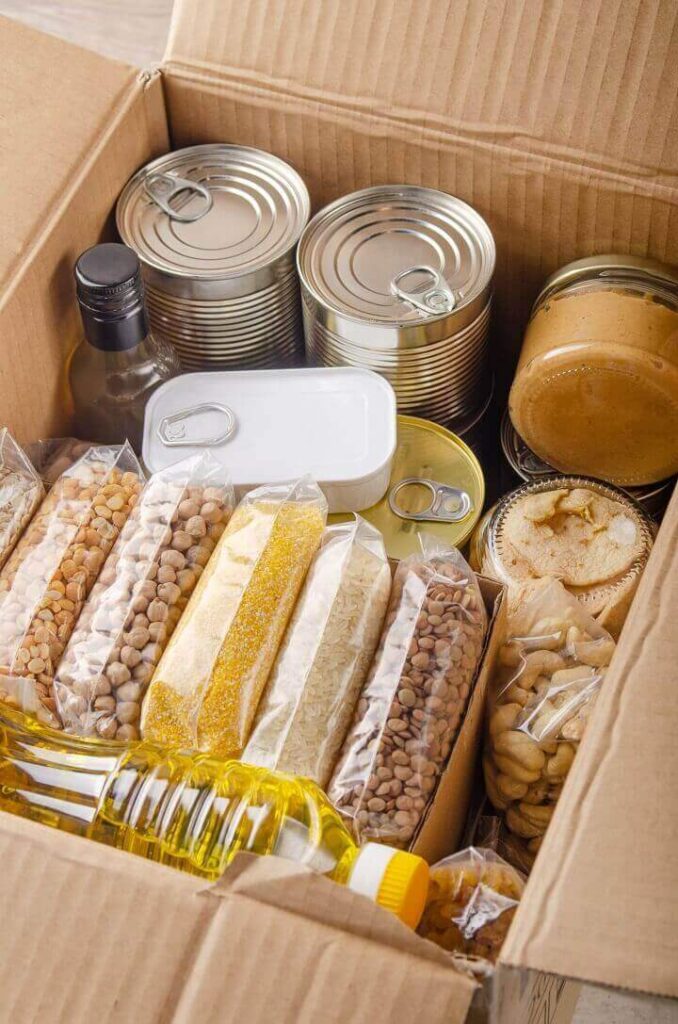
If possible, you should have shelves in your storage space. It just makes life easier. Metal shelves are the best and most durable, and they're easier to clean if a jar breaks or something leaks. They will hold up fairly well under the weight of canned foods. Wooden and plastic shelves do not offer the same strength and your food storage could end up in a pile on the floor. On a side note, packages of food should never be stored directly on the ground. A minor flood could destroy it all.
Shelves are important to have because they make it easier to rotate your food. This is very important. If you leave food buried in the back of the closet or beneath a stack of boxes, then by the time you finally get it out, it will already be spoiled. People have been known to waste thousands of dollars worth of food this way. What a waste!
From now on, whenever you go shopping, most of what you buy should go straight to the back of your food storage shelves, and the stuff in front should be pulled out to use for the coming week's meals. Here are some tips on how to rotate your food storage.
Don't compare your food cache to that of your friend who has been prepping for years. That's like comparing yourself to a marathon runner the day you start a jogging regimen. As with exercise, you have to start small and do a little bit at a time. If you don't stop, then you'll have a huge stockpile before you know it.
To help yourself stick with it, you should set goals.
This is the recommended amount of food and water you should always have on hand according to the federal government. The average household already has this much food. If you don't, then acquire it right away and use it as your jumping off point. If a disaster happens, remember that the food in the fridge should be eaten first, which means you can save your pantry food for the following day.
Now you want to take that 3 day food supply and build on it. Figure out how much food your family eats on a typical day, multiply that number by 21, and you will know how much you need. You don't have to get into bulk items quite yet at this stage. Just build up your food storage at an even pace.
When you go grocery shopping, buy extra of anything that doesn't have to be refrigerated. Try to make sure you have a little variety, too. What's something you haven't had in a while but you know your family likes? Whatever it is, grab it. Keep doing these things until you have 3 weeks of food, and don't forget to rotate.
This is where you are getting into the long term food storage items that are best purchased in bulk. Things like beans, rice, pasta, sugar, flour, and so forth. Consider getting a membership to a store like Costco or Sam's Club.
This is the stage where you'll want to learn how to cook from scratch. I know some people think cooking from scratch is a pain in the butt, but you'll save a lot of money that way. You'll also be a lot healthier. Try several different meals from scratch that you could make on your grill or camp stove if you had to, and when you find some that your family likes, buy the necessary ingredients in bulk.
Your food supply should be double the last checkpoint with a variety of foods and snacks to keep your family healthy and happy. Again, be careful about relying too much on canned foods and boxed meals. If that's all you have to eat, then your sodium levels will be through the roof which is hard on your health, especially if you're middle-aged or older. Make sure you have plenty of bulk dried foods and dehydrated foods (more on that below).
This is generally the goal for most preppers, and it might take several years to get there, but it is very doable if you're patient and persistent. But once you get to this point, don't stop prepping. You should continue rotating through your food supply and improving on it. You'll discover new foods, new recipes, new ways to store things, and so forth. The longer you maintain a year's supply of food, the better it will get.
Note: If you store this much food, make sure you pay attention to your food's shelf life. Some foods probably don't last as long as you think, while other foods last a lot longer.
Now it's time to get a little more specific. So what foods should you store exactly? The short answer is: whatever your family eats. There's an old saying: “Store what you eat and eat what you store.” That might seem a little vague, but it is the one rule you need to keep in mind when you start buying extra food.
Never store food your family hates or food your family hasn't tried, no matter how great of a deal it is. You might be thinking, “If we're hungry, we'll eat anything, so who cares?” While this is true, you still want to focus on foods that everyone will enjoy.
During a long-term disaster, it's important to do everything you can to keep up morale, and disgusting foods that no one likes will only make that more difficult. This is especially important if you have children.
Below is a list of foods with a long shelf life (a year or longer). As I mentioned above, in addition to canned and boxed foods, you'll also want plenty of baking ingredients. You should also focus on foods that can be prepared in a variety of ways so you'll have more meal options.
Note: If you store a lot of bulk dry foods like flour and rice, be sure you also buy some diatomaceous earth, which kills pests but is safe to consume. Now on to the list:
There are many other long-lasting foods, but this list is just to get the gears in your head turning. If your family has a particular staple they just can't live without, add plenty of it to your food storage. Better yet, learn to make it from scratch and stock the necessary ingredients.
Some kids and even adults have a particular snack they absolutely love. Make sure you have plenty of those things, too, as long as it's something that will last a long time (such as candy).
There are some foods that simply don't store on a shelf in the pantry very well. You'll need to either stop eating these foods or find a suitable alternative.
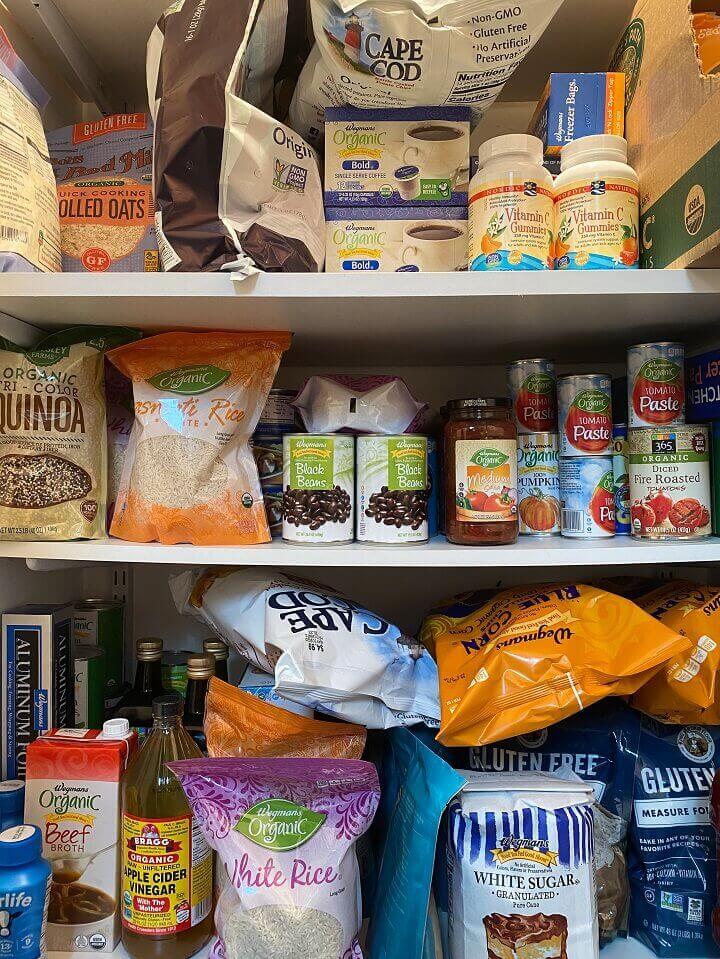
If you went through that first list and were a little surprised not to see freeze-dried anything, there is a reason for that. Freeze-dried foods deserve their own special section. They are foods that you can only buy commercially packaged.
So how are freeze dried foods different from other dried foods? Basically, they are flash frozen. This process allows the food to retain more nutritional value than the canning or drying process. It also keeps the food pretty close to its original look and flavor once it has been reconstituted with a little water.
In fact, it takes less water to bring a freeze-dried food back to its original appearance than it does dehydrated foods. In a post-disaster situation, this is a very big deal when water is scarce.
There are a ton of freeze-dried meals, like beef stroganoff or chicken teriyaki, that come in cans or pouches. Mountain House even makes emergency food buckets that come with a variety of meals. To be honest, they don't taste nearly as good as home-cooked meals, but they're still a great option if you want to be able to whip up a meal quickly and easily.
If you do buy freeze-dried food, keep in mind the servings per can are based on a calorie-specific diet. The servings are probably going to be significantly smaller than your average meal today. If you know you have some big eaters, plan accordingly and don't assume a can that says 40 servings will really amount to that much.
If you've visit many survival sites, you've no doubt seen ads for MREs. Personally, I don't recommend buying many of them, and for three reasons:
As you can see, MREs aren't something you want to spend a lot of money on. You could buy a few of them to put in your bug out bag, but that's all. Or better yet, you could make your own.
There are several tricks that will make your food storage a success. We've talked about where and what store, so now let's get into all the miscellaneous tips.
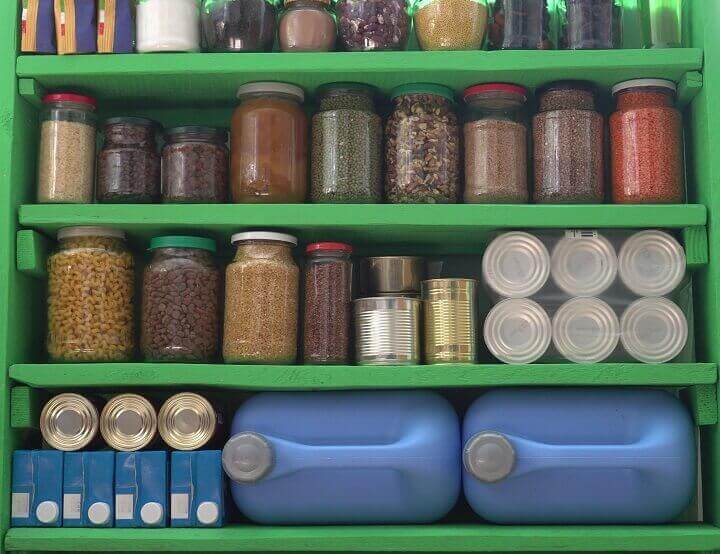
In addition to learning these food storage tips, you also need to learn these food storage mistakes.
If you are getting a little panicked at the thought of buying a lot of food that you won't be serving to your family right away, try to relax. Prepping doesn't mean you have to live on Ramen noodles while you stash away all of the good stuff. Just look for ways to save money elsewhere and do what you can.
You should also consider starting a garden and preserving whatever food it produces. Or if you have neighbors that are always offering you their excess produce, accept it and preserve it, too.
There are 2 main methods of home food preservation: canning and dehydrating.
Canning is an excellent way to preserve everything from fruits and veggies to your favorite soups and stews. It's possible to can most of the things you serve your family in a typical month. There are literally hundreds of canning and preserving recipes out there.
supplies. Expect to pay about $200 for the initial investment. It will pay for itself very quickly. The following list includes the things you will want to start looking for.
Don't be afraid to hit yard sales, check Craigslist, and secondhand stores. If you buy a used canner, make sure the seal around the inside of the lid is in good shape. Any nicks or signs of wear means you are going to need to replace the seal. Investing in a canning guide that provides you with all the important details as well as recipes is a very good idea.
The pressure canner is going to be your biggest investment. Expect to pay anywhere from $50 to $100. They can be expensive, but they're absolutely essential for safe canning.
You can get away with using a water bath canner for some fruits, but nothing else. A water bath canner is basically a large pot. The fruits, jams, and jellies are boiled for about 10 minutes in the jars and then they are safe to put on the shelf. Fruits are high in acid, which kills off the bacteria.
Home canning is fairly straightforward. It generally involves picking fresh produce when the fruit is ripe and juicy and when the veggies are crisp. The produce is thoroughly washed before the blooms are cut away, and a blanching process is used for veggies to stop bacteria growth. Blanching is where you boil the vegetables in water for a few minutes before dunking them in an ice bath for the same amount of time.
Anything else you prepare at home, like chili, soup, or even meat can be put into a glass jar and processed in your pressure canner. You will be amazed at how quickly you can fill your shelves with just a single day of canning. I recommend checking out this step-by-step canning guide at SimplyCanning.com for more info.
Dehydrating foods is another great option. The process removes moisture from the food to keep it from growing bacteria. Dehydrating is a method that has been around for centuries, but it is much easier and safer for us nowadays with the benefit of electric dehydrators. Fruits, veggies, meats and spices can all be dried and safely stored on the shelf for years. There are hundreds of dehydrating recipes to try.
A good dehydrator will run you at least $60. A high-end dehydrator could cost as much as $250. To dehydrate your food, you will need to wash and dry it thoroughly before slicing it into very thin strips. Thin strips of fruit and meat will dry quickly and you won't have to worry too much about them turning chewy and tough to eat. However, with a thin strip, you run the risk of the food becoming crunchy and falling apart when handled.
Dehydrating food is something that takes practice, so you might want to consider getting a dehydrator cookbook to help you along the way. You will quickly get the hang of cutting certain fruits, veggies, and meat. You will also learn just how long they need to sit in the dehydrator.
There are a ton of different seasoning mixtures and marinades you can use on meat to give them additional flavor. When food is dehydrated, it does tend to lose some of its flavoring as well as nutritional value. Fruits are often a little better when sprayed with lemon juice or citric acid before the drying process to help them retain a more natural color.
Smoking meat is another ancient preservation method. It is essentially drying, but it is done over wood chips that give the meat additional flavor. This is something many hunters get a real thrill out of doing.
Harvesting meat from the wild and then making jerky in their own smoker is very satisfying. They get to experiment with a variety of flavors that are enhanced by the type of wood chips that are used.
When smoking is used to preserve meat so that it doesn't need refrigeration, it is referred to as hard smoking. As you probably know, you can buy smoked hams and whatnot at the grocery store. That is a different process and a ham or other cut of meat that has been smoked still requires refrigeration. Your goal is to store meats and other food without the need for your big freezer.
If you're interested in trying this method, here is a picture guide to smoking meat.
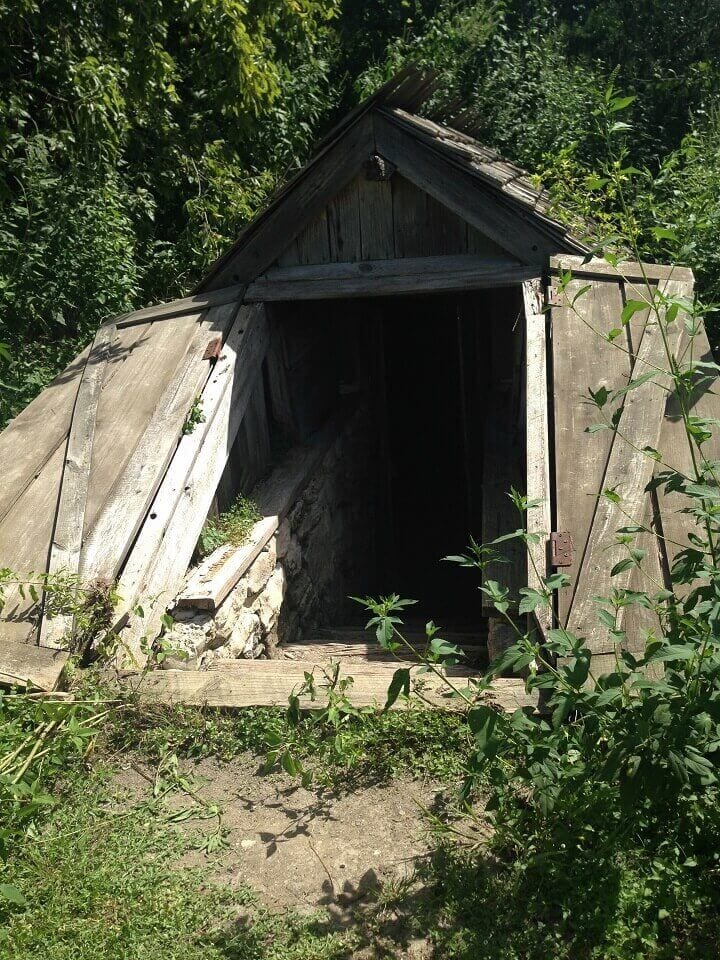
It would be a very wise decision to build or dig a root cellar on your property if you can. This is an excellent way to store fresh produce for months. Fresh is absolutely best and anytime you can eat fresh food over canned or dried, you will want to.
Root cellars keep the food at a nice, cool temperature with just the right amount of humidity. There is very little you need to do after you put your food in a root cellar. Nature takes care of it all for you.
The only real concern you will have is making sure you use wood shelving and allowing plenty of space between the produce in the cellar. Wood shelving will not retain heat or cold that could throw off the temperature in the root cellar like metal shelving, and the food will need good air circulation.
The key to keeping root crops fresh in storage is to harvest them and leave them as is. That means don't wash the dirt off. The soil helps preserve them and keep them cool.
Keep a close watch on the food in your root cellar. If a potato or one of your other bits of produce looks to be going bad, get rid of it quickly. One bad apple really can ruin an entire bunch. Don't store your produce in buckets or bags. Lay it all out flat. When harvesting, make sure the produce isn't bruised. A bruise leads to quick rotting.
Prepping is a journey, not a race. Take your time and build up a food stockpile that will satisfy your family and give you peace of mind knowing you can put food on the table no matter what disaster comes your way.
Remember, this article is just an introduction to food storage. If you really want to be a food storage guru, I highly recommend you pick up some books on the topic.
Like this post? Don't forget to Pin It on Pinterest!